How Many Pan-Arctic Lakes Are Observed by ICESat-2 in Space and Time?
Abstract
:1. Introduction
2. Materials and Methods
2.1. ICESat-2 ATLAS ATL13 Data
2.2. Auxiliary Data
2.3. SWL Calculation by ICESat-2 Temporal Coverage Patterns
2.4. Spatial Pattern Analysis of SWL
3. Results and Analyses
3.1. ICESat-2 Observation Coverage of Pan-Arctic Lakes
3.2. Temporal Coverage Patterns of Pan-Arctic Lakes
3.3. Spatial Pattern of SWL Changes
4. Discussion
4.1. Comparison of Altimetry and Gauged Water Level
4.2. Characteristics of SWL Change and Potential Causes
4.3. ICESat-2 ATL13 Product-Derived Water Levels
5. Conclusions
Author Contributions
Funding
Data Availability Statement
Acknowledgments
Conflicts of Interest
References
- Messager, M.L.; Lehner, B.; Grill, G.; Nedeva, I.; Schmitt, O. Estimating the volume and age of water stored in global lakes using a geo-statistical approach. Nat. Commun. 2016, 7, 13603. [Google Scholar] [CrossRef] [PubMed]
- Li, X.; Peng, S.; Xi, Y.; Woolway, R.I.; Liu, G. Earlier ice loss accelerates lake warming in the Northern Hemisphere. Nat. Commun. 2022, 13, 5156. [Google Scholar] [CrossRef] [PubMed]
- Urbański, J.A. Monitoring and classification of high Arctic lakes in the Svalbard Islands using remote sensing. Int. J. Appl. Earth Obs. Geoinf. 2022, 112, 102911. [Google Scholar] [CrossRef]
- Lehnherr, I.; St Louis, V.L.; Sharp, M.; Gardner, A.S.; Smol, J.P.; Schiff, S.L.; Muir, D.C.; Mortimer, C.A.; Michelutti, N.; Tarnocai, C. The world’s largest High Arctic lake responds rapidly to climate warming. Nat. Commun. 2018, 9, 1290. [Google Scholar] [CrossRef] [PubMed] [Green Version]
- Drake, T.W.; Holmes, R.M.; Zhulidov, A.V.; Gurtovaya, T.; Raymond, P.A.; McClelland, J.W.; Spencer, R.G. Multidecadal climate-induced changes in Arctic tundra lake geochemistry and geomorphology. Limnol. Oceanogr. 2019, 64, S179–S191. [Google Scholar] [CrossRef] [Green Version]
- Birkett, C.J.E. Transactions American Geophysical Union. Radar altimetry: A new concept in monitoring lake level changes. Eos Trans. Am. Geophys. Union 1994, 75, 273–275. [Google Scholar] [CrossRef]
- Crétaux, J.-F.; Arsen, A.; Calmant, S.; Kouraev, A.; Vuglinski, V.; Bergé-Nguyen, M.; Gennero, M.-C.; Nino, F.; Del Rio, R.A.; Cazenave, A. SOLS: A lake database to monitor in the Near Real Time water level and storage variations from remote sensing data. Adv. Space Res. 2011, 47, 1497–1507. [Google Scholar] [CrossRef]
- Song, C.; Huang, B.; Ke, L. Modeling and analysis of lake water storage changes on the Tibetan Plateau using multi-mission satellite data. Remote Sens. Environ. 2013, 135, 25–35. [Google Scholar] [CrossRef]
- Crétaux, J.-F.; Birkett, C. Lake studies from satellite radar altimetry. C. R. Geosci. 2006, 338, 1098–1112. [Google Scholar] [CrossRef]
- Zhang, G.; Xie, H.; Kang, S.; Yi, D.; Ackley, S.F. Monitoring lake level changes on the Tibetan Plateau using ICESat altimetry data (2003–2009). Remote Sens. Environ. 2011, 115, 1733–1742. [Google Scholar] [CrossRef]
- Busker, T.; de Roo, A.; Gelati, E.; Schwatke, C.; Adamovic, M.; Bisselink, B.; Pekel, J.-F.; Cottam, A. A global lake and reservoir volume analysis using a surface water dataset and satellite altimetry. Hydrol. Earth Syst. Sci. 2019, 23, 669–690. [Google Scholar] [CrossRef] [Green Version]
- Abdalla, S.; Kolahchi, A.A.; Ablain, M.; Adusumilli, S.; Bhowmick, S.A.; Alou-Font, E.; Amarouche, L.; Andersen, O.B.; Antich, H.; Aouf, L. Altimetry for the future: Building on 25 years of progress. Adv. Space Res. 2021, 68, 319–363. [Google Scholar] [CrossRef]
- Da Silva, J.S.; Calmant, S.; Seyler, F.; Rotunno Filho, O.C.; Cochonneau, G.; Mansur, W.J. Water levels in the Amazon basin derived from the ERS 2 and ENVISAT radar altimetry missions. Remote Sens. Environ. 2010, 114, 2160–2181. [Google Scholar] [CrossRef]
- Alsdorf, D.; Birkett, C.; Dunne, T.; Melack, J.; Hess, L. Water level changes in a large Amazon lake measured with spaceborne radar interferometry and altimetry. Geophys. Res. Lett. 2001, 28, 2671–2674. [Google Scholar] [CrossRef]
- Zakharova, E.A.; Kouraev, A.V.; Rémy, F.; Zemtsov, V.A.; Kirpotin, S.N. Seasonal variability of the Western Siberia wetlands from satellite radar altimetry. J. Hydrol. 2014, 512, 366–378. [Google Scholar] [CrossRef]
- Yang, Y.; Moore, P.; Li, Z.; Li, F. Lake Level Change from Satellite Altimetry Over Seasonally Ice-Covered Lakes in the Mackenzie River Basin. IEEE Trans. Geosci. Remote Sens. 2020, 59, 8143–8152. [Google Scholar] [CrossRef]
- Chen, T.; Song, C.; Ke, L.; Wang, J.; Liu, K.; Wu, Q. Estimating seasonal water budgets in global lakes by using multi-source remote sensing measurements. J. Hydrol. 2021, 593, 125781. [Google Scholar] [CrossRef]
- Shu, S.; Liu, H.; Beck, R.A.; Frappart, F.; Korhonen, J.; Xu, M.; Yang, B.; Hinkel, K.M.; Huang, Y.; Yu, B. Analysis of Sentinel-3 SAR altimetry waveform retracking algorithms for deriving temporally consistent water levels over ice-covered lakes. Remote Sens. Environ. 2020, 239, 111643. [Google Scholar] [CrossRef]
- Lawrence, I.R.; Armitage, T.W.; Tsamados, M.C.; Stroeve, J.C.; Dinardo, S.; Ridout, A.L.; Muir, A.; Tilling, R.L.; Shepherd, A. Extending the Arctic sea ice freeboard and sea level record with the Sentinel-3 radar altimeters. Adv. Space Res. 2021, 68, 711–723. [Google Scholar] [CrossRef]
- Zhang, X.; Jiang, L.; Kittel, C.M.; Yao, Z.; Nielsen, K.; Liu, Z.; Wang, R.; Liu, J.; Andersen, O.B.; Bauer-Gottwein, P. On the performance of Sentinel-3 altimetry over new reservoirs: Approaches to determine onboard a priori elevation. Geophys. Res. Lett. 2020, 47, e2020GL088770. [Google Scholar] [CrossRef]
- Taburet, N.; Zawadzki, L.; Vayre, M.; Blumstein, D.; Le Gac, S.; Boy, F.; Raynal, M.; Labroue, S.; Crétaux, J.-F.; Femenias, P. S3MPC: Improvement on inland water tracking and water level monitoring from the OLTC onboard Sentinel-3 altimeters. Remote Sens. 2020, 12, 3055. [Google Scholar] [CrossRef]
- Shu, S.; Liu, H.; Frappart, F.; Huang, Y.; Wang, S.; Hinkel, K.M.; Beck, R.A.; Yu, B.; Jones, B.M.; Arp, C.D. Estimation of snow accumulation over frozen Arctic lakes using repeat ICESat laser altimetry observations—A case study in northern Alaska. Remote Sens. Environ. 2018, 216, 529–543. [Google Scholar] [CrossRef]
- Song, C.; Sheng, Y.; Ke, L.; Nie, Y.; Wang, J. Glacial lake evolution in the southeastern Tibetan Plateau and the cause of rapid expansion of proglacial lakes linked to glacial-hydrogeomorphic processes. J. Hydrol. 2016, 540, 504–514. [Google Scholar] [CrossRef] [Green Version]
- Song, C.; Sheng, Y. Contrasting evolution patterns between glacier-fed and non-glacier-fed lakes in the Tanggula Mountains and climate cause analysis. Clim. Chang. 2016, 135, 493–507. [Google Scholar] [CrossRef]
- Yi, S.; Wang, Q.; Chang, L.; Sun, W.J.R.S. Changes in mountain glaciers, lake levels, and snow coverage in the Tianshan monitored by GRACE, ICESat, altimetry, and MODIS. Remote Sens. 2016, 8, 798. [Google Scholar] [CrossRef] [Green Version]
- Neumann, T.; Brenner, A.; Hancock, D.; Robbins, J.; Saba, J.; Harbeck, K.; Gibbons, A.; Lee, J.; Luthcke, S.; Rebold, T. ATLAS/ICESat-2 L2A Global Geolocated Photon Data, Version 3; NASA National Snow and Ice Data Center Distributed Active Archive Center: Boulder, CO, USA, 2020. [Google Scholar]
- Yuan, C.; Gong, P.; Bai, Y. Performance assessment of ICESat-2 laser altimeter data for water-level measurement over lakes and reservoirs in China. Remote Sens. 2020, 12, 770. [Google Scholar] [CrossRef] [Green Version]
- Madson, A.; Sheng, Y. Automated Water Level Monitoring at the Continental Scale from ICESat-2 Photons. Remote Sens. 2021, 13, 3631. [Google Scholar] [CrossRef]
- Ryan, J.C.; Smith, L.C.; Cooley, S.W.; Pitcher, L.H.; Pavelsky, T.M. Global characterization of inland water reservoirs using ICESat-2 altimetry and climate reanalysis. Geophys. Res. Lett. 2020, 47, e2020GL088543. [Google Scholar] [CrossRef]
- Cooley, S.W.; Ryan, J.C.; Smith, L.C. Human alteration of global surface water storage variability. Nature 2021, 591, 78–81. [Google Scholar] [CrossRef]
- Feng, Y.; Zhang, H.; Tao, S.; Ao, Z.; Song, C.; Chave, J.; Le Toan, T.; Xue, B.; Zhu, J.; Pan, J. Decadal Lake Volume Changes (2003–2020) and Driving Forces at a Global Scale. Remote Sens. 2022, 14, 1032. [Google Scholar] [CrossRef]
- Luo, S.; Song, C.; Ke, L.; Zhan, P.; Fan, C.; Liu, K.; Chen, T.; Wang, J.; Zhu, J. Satellite laser altimetry reveals a net water mass gain in global lakes with spatial heterogeneity in the early 21st century. Geophys. Res. Lett. 2022, 49, e2021GL096676. [Google Scholar] [CrossRef]
- Xu, N.; Ma, Y.; Wei, Z.; Huang, C.; Li, G.; Zheng, H.; Wang, X.H. Satellite observed recent rising water levels of global lakes and reservoirs. Environ. Res. Lett. 2022, 17, 074013. [Google Scholar] [CrossRef]
- Xu, N.; Zheng, H.; Ma, Y.; Yang, J.; Liu, X.; Wang, X. Global estimation and assessment of monthly lake/reservoir water level changes using ICESat-2 ATL13 Products. Remote Sens. 2021, 13, 2744. [Google Scholar] [CrossRef]
- Neumann, T.A.; Martino, A.J.; Markus, T.; Bae, S.; Bock, M.R.; Brenner, A.C.; Brunt, K.M.; Cavanaugh, J.; Fernandes, S.T.; Hancock, D.W. The Ice, Cloud, and Land Elevation Satellite–2 Mission: A global geolocated photon product derived from the advanced topographic laser altimeter system. Remote Sens. Environ. 2019, 233, 111325. [Google Scholar] [CrossRef] [PubMed]
- Jasinski, M.; Stoll, J.; Hancock, D.; Robbins, J.; Nattala, J.; Morison, J.; Jones, B.; Ondrusek, M.; Pavelsky, T.; Parrish, C. Algorithm Theoretical Basis Document (ATBD) for along Track Inland Surface Water Data, Release 004. 2021; Goddard Space Flight Center: Greenbelt, MD, USA, 2021.
- Schwatke, C.; Dettmering, D.; Bosch, W.; Seitz, F. DAHITI—An innovative approach for estimating water level time series over inland waters using multi-mission satellite altimetry. Hydrol. Earth Syst. Sci. 2015, 19, 4345–4364. [Google Scholar] [CrossRef] [Green Version]
- Setiawan, B. A simple method to determine patterns of wet and dry seasons. In Proceedings of the IOP Conference Series: Earth and Environmental Science; IOP Publishing: Bristol, UK, 2020; p. 12055. [Google Scholar]
- Schindler, D.W.; Smol, J.P. Cumulative effects of climate warming and other human activities on freshwaters of Arctic and subarctic North America. AMBIO J. Hum. Environ. 2006, 35, 160–168. [Google Scholar] [CrossRef]
- Mueller, D.R.; Van Hove, P.; Antoniades, D.; Jeffries, M.O.; Vincent, W.F. High Arctic lakes as sentinel ecosystems: Cascading regime shifts in climate, ice cover, and mixing. Limnol. Oceanogr. 2009, 54, 2371–2385. [Google Scholar] [CrossRef]
- Urabe, A.; Tateishi, M.; Inouchi, Y.; Matsuoka, H.; Inoue, T.; Dmytriev, A.; Khlystov, O.M. Lake-level changes during the past 100,000 years at Lake Baikal, southern Siberia. Quat. Res. 2004, 62, 214–222. [Google Scholar] [CrossRef]
- Juschus, O.; Pavlov, M.; Schwamborn, G.; Preusser, F.; Fedorov, G.; Melles, M. Late Quaternary lake-level changes of Lake El’gygytgyn, NE Siberia. Quat. Res. 2011, 76, 441–451. [Google Scholar] [CrossRef] [Green Version]
- Rémy, F.; Parouty, S. Antarctic ice sheet and radar altimetry: A review. Remote Sens. 2009, 1, 1212–1239. [Google Scholar] [CrossRef]
- Quartly, G.D.; Chen, G.; Nencioli, F.; Morrow, R.; Picot, N. An overview of requirements, procedures and current advances in the calibration/validation of radar altimeters. Remote Sens. 2021, 13, 125. [Google Scholar] [CrossRef]
- Birkett, C.M.; Beckley, B. Investigating the performance of the Jason-2/OSTM radar altimeter over lakes and reservoirs. Mar. Geod. 2010, 33, 204–238. [Google Scholar] [CrossRef]
- Adam, J.C.; Hamlet, A.F.; Lettenmaier, D.P. Implications of global climate change for snowmelt hydrology in the twenty-first century. Hydrol. Process. Int. J. 2009, 23, 962–972. [Google Scholar] [CrossRef]
- Laurent, L.; Buoncristiani, J.F.; Pohl, B.; Zekollari, H.; Farinotti, D.; Huss, M.; Mugnier, J.L.; Pergaud, J. The impact of climate change and glacier mass loss on the hydrology in the Mont-Blanc massif. Sci. Rep. 2020, 10, 10420. [Google Scholar] [CrossRef]
- Day, C.A. Modelling impacts of climate change on snowmelt runoff generation and streamflow across western US mountain basins: A review of techniques and applications for water resource management. Prog. Phys. Geog. 2009, 33, 614–633. [Google Scholar] [CrossRef]
- Pederson, G.T.; Gray, S.T.; Ault, T.; Marsh, W.; Fagre, D.B.; Bunn, A.G.; Graumlich, L.J. Climatic controls on the snowmelt hydrology of the northern Rocky Mountains. J. Clim. 2011, 24, 1666–1687. [Google Scholar] [CrossRef]
- Zona, D.; Lafleur, P.M.; Hufkens, K.; Bailey, B.; Gioli, B.; Burba, G.; Oechel, W.C. Earlier snowmelt may lead to late season declines in plant productivity and carbon sequestration in Arctic tundra ecosystems. Sci. Rep. 2022, 12, 3986. [Google Scholar]
- Casson, D.R.; Werner, M.; Weerts, A.; Solomatine, D. Global re-analysis datasets to improve hydrological assessment and snow water equivalent estimation in a sub-Arctic watershed. Hydrol. Earth Syst. Sci. 2018, 22, 4685–4697. [Google Scholar] [CrossRef] [Green Version]
- Luo, S.; Song, C.; Zhan, P.; Liu, K.; Chen, T.; Li, W.; Ke, L. Refined estimation of lake water level and storage changes on the Tibetan Plateau from ICESat/ICESat-2. Catena 2021, 200, 105177. [Google Scholar] [CrossRef]
- Zhang, G.; Chen, W.; Xie, H. Tibetan Plateau’s lake level and volume changes from NASA’s ICESat/ICESat-2 and Landsat Missions. Geophys. Res. Lett. 2019, 46, 13107–13118. [Google Scholar] [CrossRef]
- Dandabathula, G.; Verma, M.; Satyanarayana, P.; Rao, S.S. Evaluation of ICESat-2 ATL08 data product: Performance assessment in inland water. EJ-GEO 2020, 1. [Google Scholar] [CrossRef]
- Dandabathula, G.; Rao, S.S. Validation of ICESat-2 surface water level product ATL13 with near real time gauge data. Hydrology 2020, 8, 19–25. [Google Scholar] [CrossRef]
- Narin, O.G.; Abdikan, S. Multi-temporal analysis of inland water level change using ICESat-2 ATL-13 data in lakes and dams. Environ. Sci. Pollut. R 2022, 1–13. [Google Scholar] [CrossRef]
- Fricker, H.A.; Arndt, P.; Brunt, K.M.; Datta, R.T.; Fair, Z.; Jasinski, M.F.; Wouters, B. ICESat-2 Meltwater Depth Estimates: Application to Surface Melt on Amery Ice Shelf, East Antarctica. Geophys. Res. Lett. 2021, 48, e2020GL090550. [Google Scholar] [CrossRef]
- Fan, Y.; Hao, W.; Zhang, B.; Ma, C.; Gao, S.; Shen, X.; Li, F. Monitoring the Hydrological Activities of Antarctic Subglacial Lakes Using CryoSat-2 and ICESat-2 Altimetry Data. Remote Sens. 2022, 14, 898. [Google Scholar] [CrossRef]

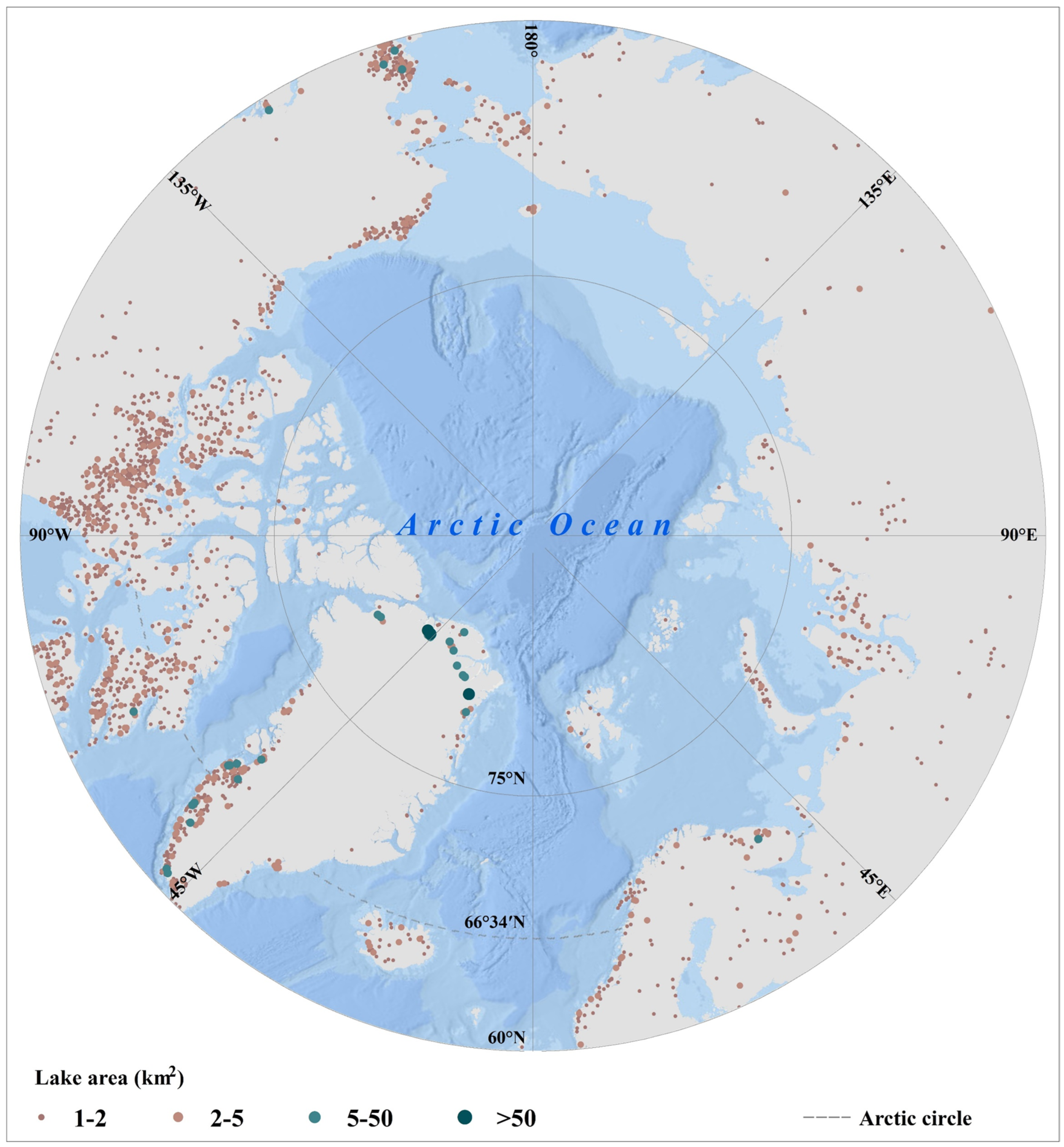
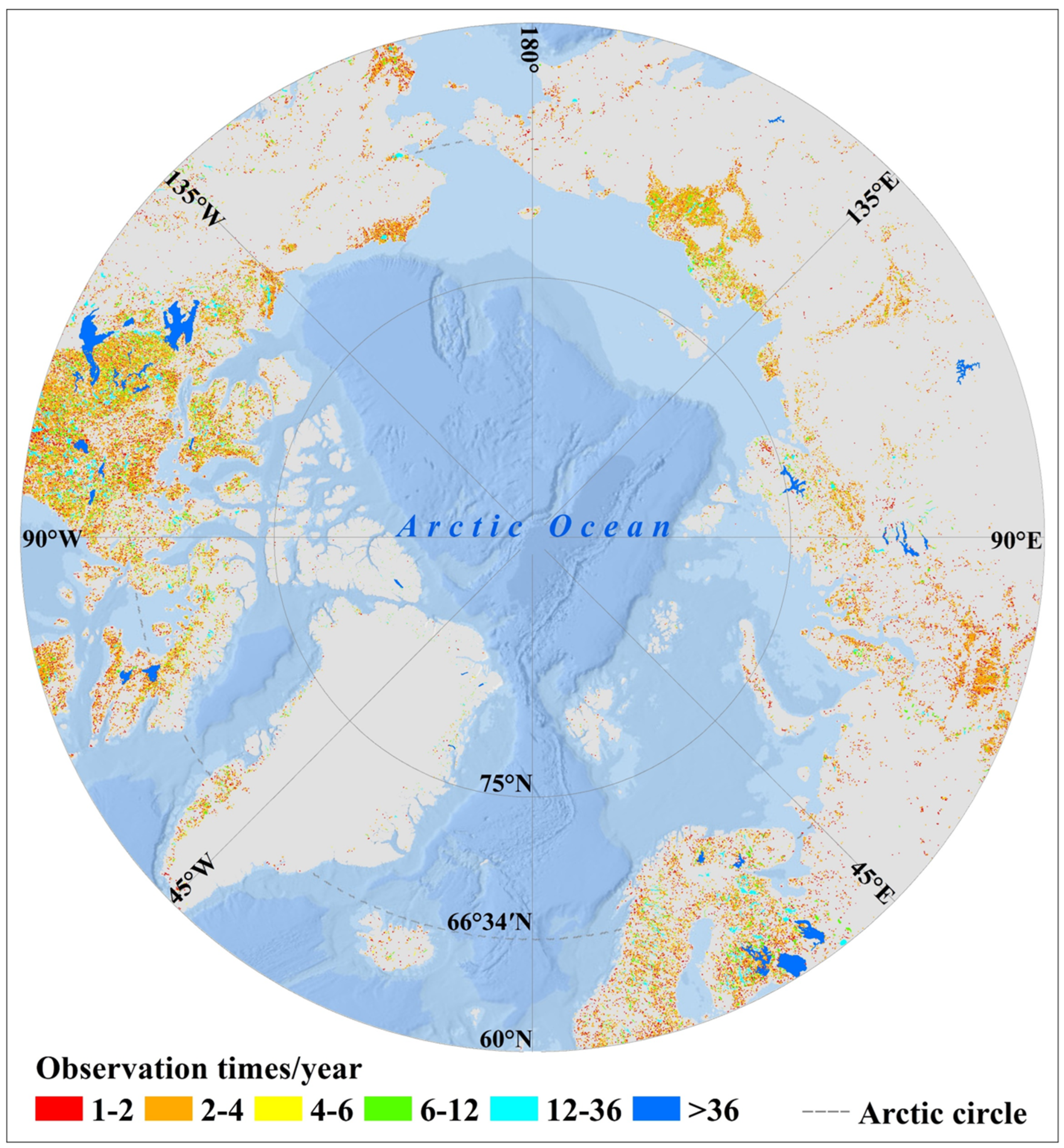
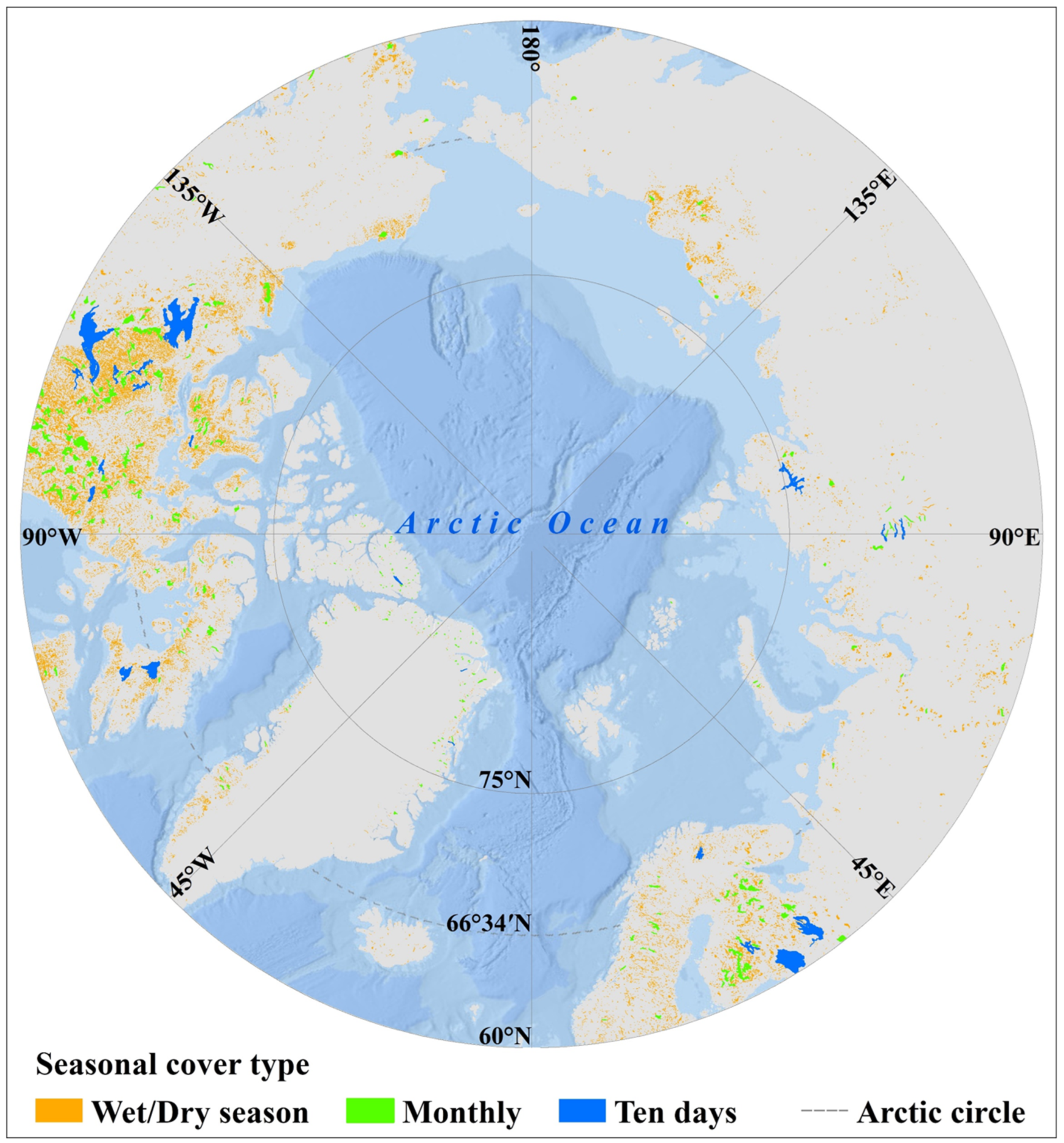
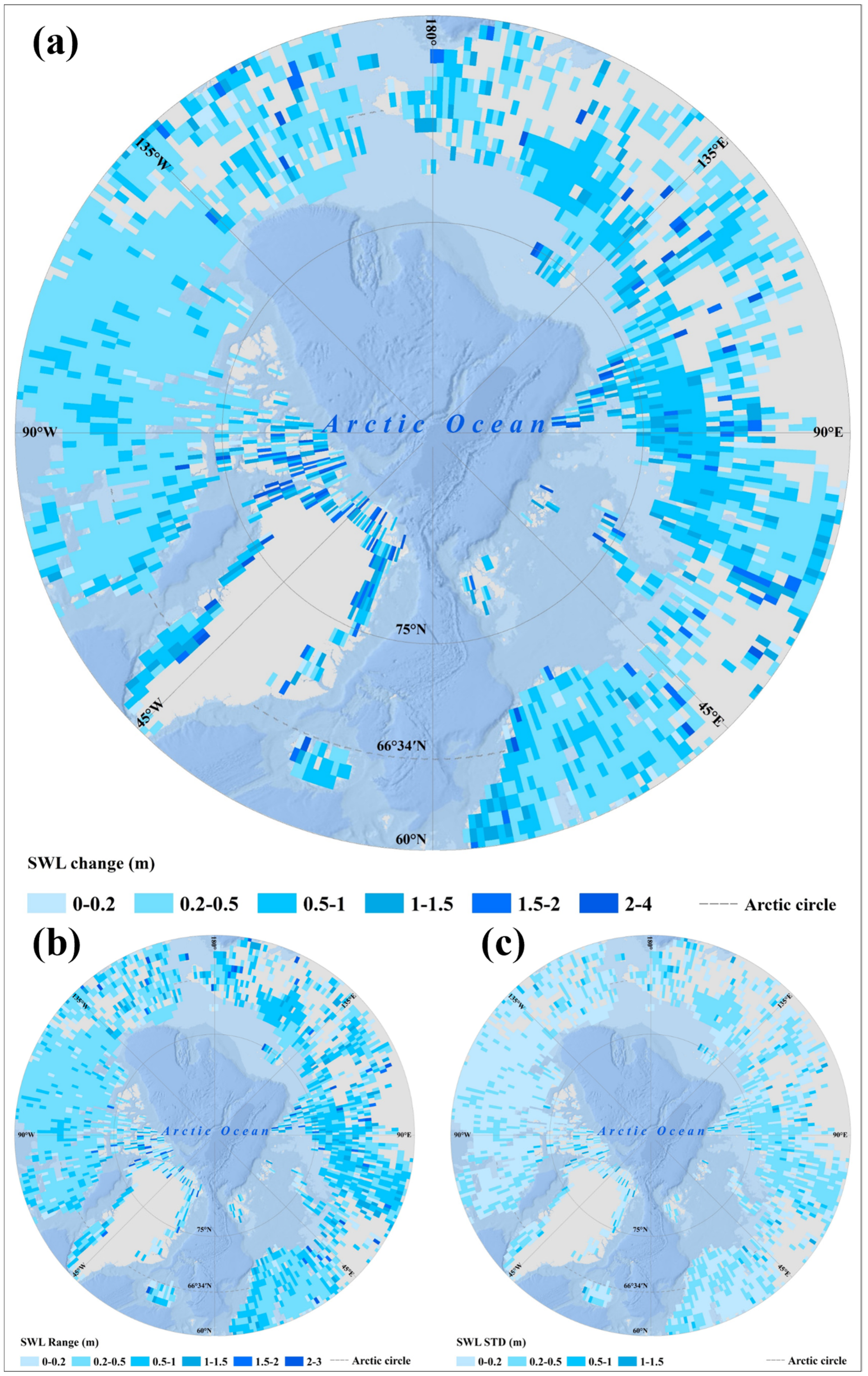
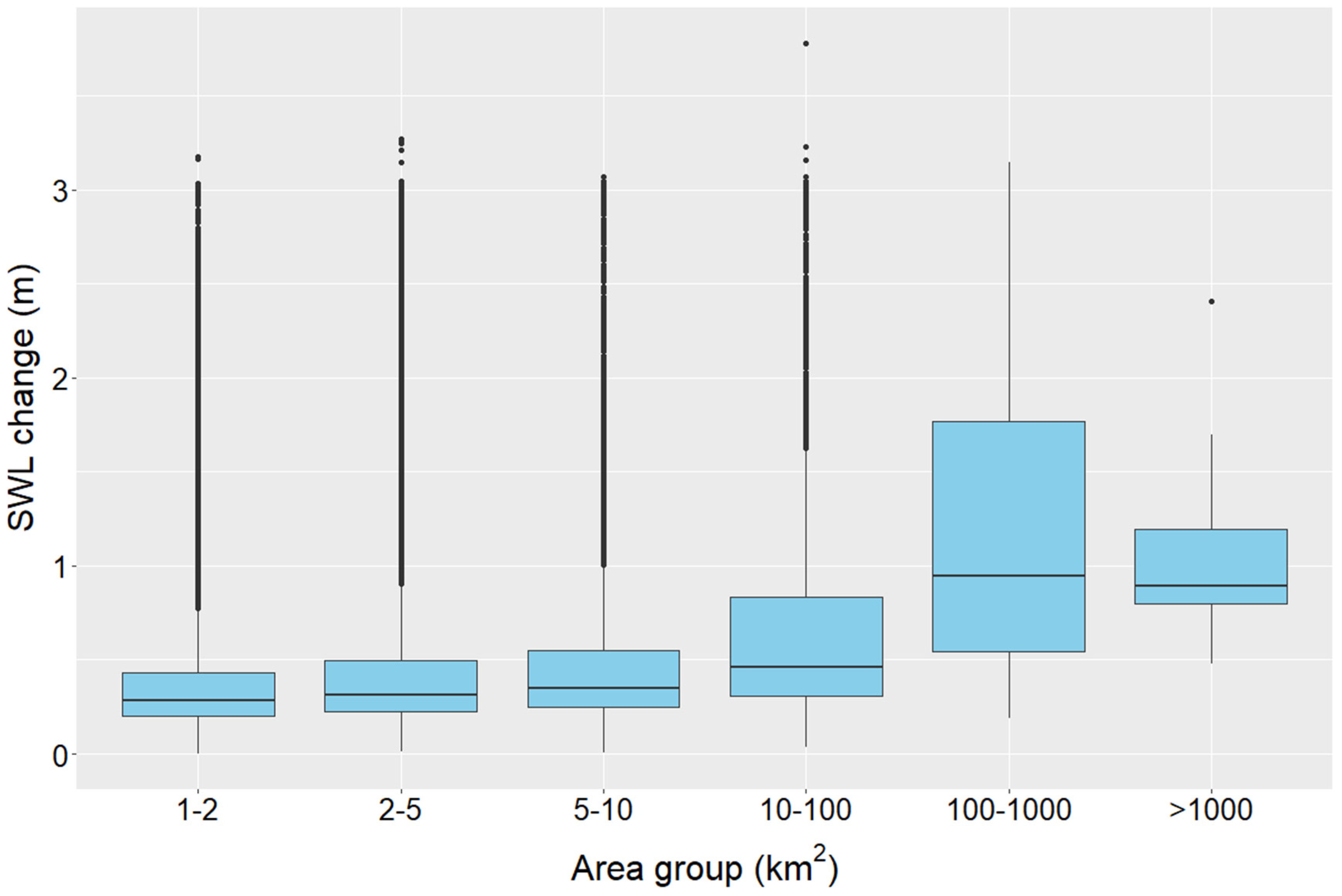
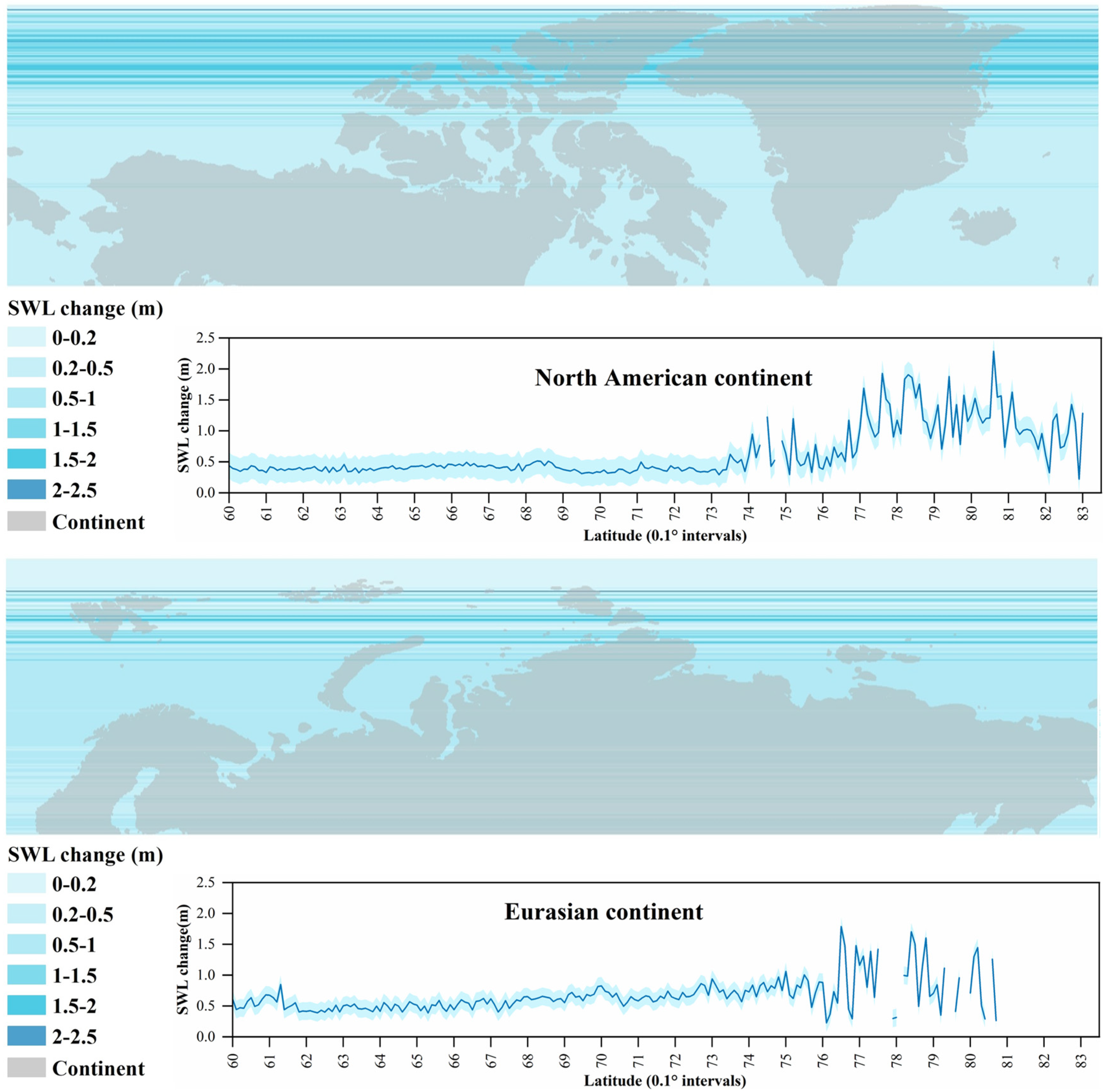


| Categories | Day | Month | Year |
|---|---|---|---|
| Wet/dry season | Obs. months/year ≥2 (interval >4) | 3/3 | |
| Monthly | Obs. months/year ≥11 | 3/3 | |
| Ten-day | Obs.1 days/ten-day ≥1 | Obs. months/year ≥11 | 3/3 |
| Area | Time Scale | Total | |||
|---|---|---|---|---|---|
| Non-Seasonal | Wet and Dry Seasons | Monthly | Ten-Day | ||
| 1–2 km2 | 27,925 | 15,454 | 6 | 43,385 | |
| 2–5 km2 | 10,632 | 14,094 | 27 | 24,753 | |
| 5–10 km2 | 1633 | 5477 | 29 | 7139 | |
| 10–100 km2 | 306 | 4624 | 109 | 5039 | |
| 100–1000 km2 | 196 | 145 | 9 | 350 | |
| >1000 km2 | 10 | 12 | 22 | ||
| Total | 40,496 | 39,845 | 326 | 21 | 80,688 |
| Area Threshold | SWL Change (m) | |||
|---|---|---|---|---|
| Median | Mean | Range | STD | |
| 1–2 km2 | 0.313 | 0.323 | 0.250 | 0.058 |
| 2–5 km2 | 0.335 | 0.349 | 0.260 | 0.069 |
| 5–10 km2 | 0.361 | 0.383 | 0.339 | 0.091 |
| 10–100 km2 | 0.494 | 0.519 | 0.499 | 0.126 |
| 100–1000 km2 | 0.938 | 1.050 | 1.202 | 0.350 |
| >1000 km2 | 0.907 | 0.985 | 0.451 | 0.156 |
Publisher’s Note: MDPI stays neutral with regard to jurisdictional claims in published maps and institutional affiliations. |
© 2022 by the authors. Licensee MDPI, Basel, Switzerland. This article is an open access article distributed under the terms and conditions of the Creative Commons Attribution (CC BY) license (https://creativecommons.org/licenses/by/4.0/).
Share and Cite
Chen, T.; Song, C.; Zhan, P.; Ma, J. How Many Pan-Arctic Lakes Are Observed by ICESat-2 in Space and Time? Remote Sens. 2022, 14, 5971. https://doi.org/10.3390/rs14235971
Chen T, Song C, Zhan P, Ma J. How Many Pan-Arctic Lakes Are Observed by ICESat-2 in Space and Time? Remote Sensing. 2022; 14(23):5971. https://doi.org/10.3390/rs14235971
Chicago/Turabian StyleChen, Tan, Chunqiao Song, Pengfei Zhan, and Jinsong Ma. 2022. "How Many Pan-Arctic Lakes Are Observed by ICESat-2 in Space and Time?" Remote Sensing 14, no. 23: 5971. https://doi.org/10.3390/rs14235971







